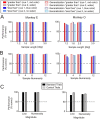Representation of abstract quantitative rules applied to spatial and numerical magnitudes in primate prefrontal cortex
- PMID: 23616557
- PMCID: PMC6619563
- DOI: 10.1523/JNEUROSCI.5827-12.2013
Representation of abstract quantitative rules applied to spatial and numerical magnitudes in primate prefrontal cortex
Abstract
Processing quantity information based on abstract principles is central to intelligent behavior. Neural correlates of quantitative rule selectivity have been identified previously in the prefrontal cortex (PFC). However, whether individual neurons represent rules applied to multiple magnitude types is unknown. We recorded from PFC neurons while monkeys switched between "greater than/less than" rules applied to spatial and numerical magnitudes. A majority of rule-selective neurons responded only to the quantitative rules applied to one specific magnitude type. However, another population of neurons generalized the magnitude principle and represented the quantitative rules related to both magnitudes. This indicates that the primate brain uses rule-selective neurons specialized in guiding decisions related to a specific magnitude type only, as well as generalizing neurons that respond abstractly to the overarching concept "magnitude rules."
Figures







Similar articles
-
Rule activity related to spatial and numerical magnitudes: comparison of prefrontal, premotor, and cingulate motor cortices.J Cogn Neurosci. 2014 May;26(5):1000-12. doi: 10.1162/jocn_a_00545. Epub 2013 Dec 17. J Cogn Neurosci. 2014. PMID: 24345164
-
Basic mathematical rules are encoded by primate prefrontal cortex neurons.Proc Natl Acad Sci U S A. 2010 Feb 2;107(5):2277-82. doi: 10.1073/pnas.0909180107. Epub 2010 Jan 19. Proc Natl Acad Sci U S A. 2010. PMID: 20133872 Free PMC article.
-
From rule to response: neuronal processes in the premotor and prefrontal cortex.J Neurophysiol. 2003 Sep;90(3):1790-806. doi: 10.1152/jn.00086.2003. Epub 2003 May 7. J Neurophysiol. 2003. PMID: 12736235
-
Category representation and generalization in the prefrontal cortex.Eur J Neurosci. 2012 Apr;35(7):1083-91. doi: 10.1111/j.1460-9568.2011.07981.x. Eur J Neurosci. 2012. PMID: 22487038 Review.
-
Prefrontal cortex and working memory processes.Neuroscience. 2006 Apr 28;139(1):251-61. doi: 10.1016/j.neuroscience.2005.07.003. Epub 2005 Dec 1. Neuroscience. 2006. PMID: 16325345 Review.
Cited by
-
The neurobiology of innate, volitional and learned vocalizations in mammals and birds.Philos Trans R Soc Lond B Biol Sci. 2020 Jan 6;375(1789):20190054. doi: 10.1098/rstb.2019.0054. Epub 2019 Nov 18. Philos Trans R Soc Lond B Biol Sci. 2020. PMID: 31735150 Free PMC article. Review.
-
Context-Dependent Duration Signals in the Primate Prefrontal Cortex.Cereb Cortex. 2016 Aug;26(8):3345-56. doi: 10.1093/cercor/bhv156. Epub 2015 Jul 24. Cereb Cortex. 2016. PMID: 26209845 Free PMC article.
-
Sensory and Working Memory Representations of Small and Large Numerosities in the Crow Endbrain.J Neurosci. 2016 Nov 23;36(47):12044-12052. doi: 10.1523/JNEUROSCI.1521-16.2016. J Neurosci. 2016. PMID: 27881787 Free PMC article.
-
Distinct neural networks for the volitional control of vocal and manual actions in the monkey homologue of Broca's area.Elife. 2021 Feb 3;10:e62797. doi: 10.7554/eLife.62797. Elife. 2021. PMID: 33534697 Free PMC article.
-
Dopamine regulates two classes of primate prefrontal neurons that represent sensory signals.J Neurosci. 2013 Aug 21;33(34):13724-34. doi: 10.1523/JNEUROSCI.0210-13.2013. J Neurosci. 2013. PMID: 23966694 Free PMC article.
References
Publication types
MeSH terms
LinkOut - more resources
Full Text Sources
Other Literature Sources
Miscellaneous
